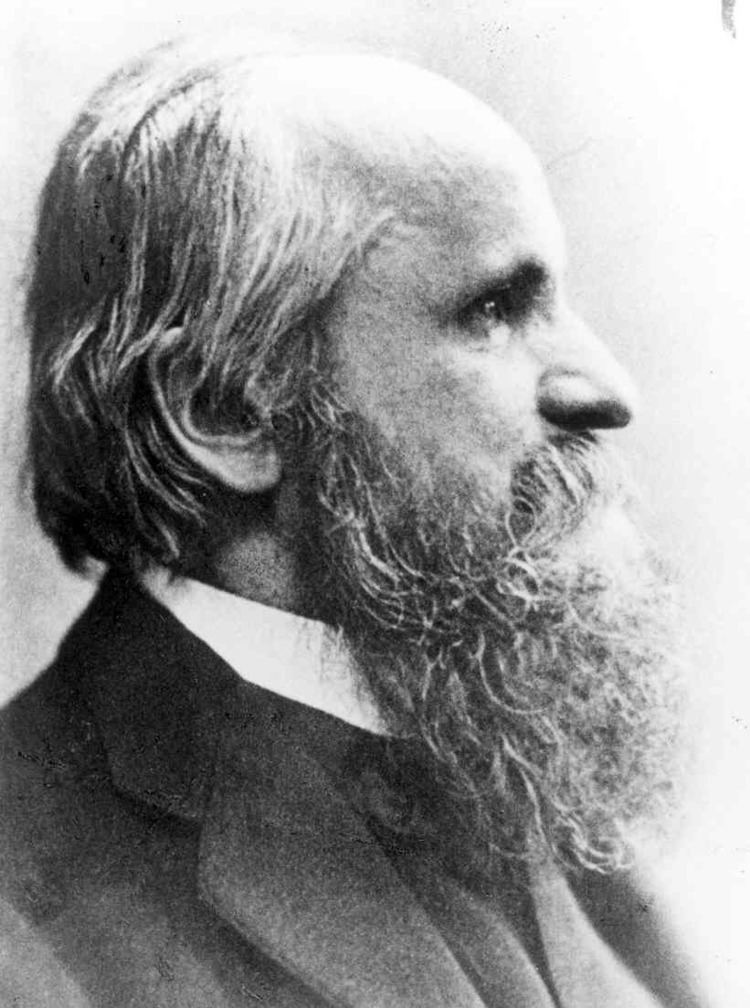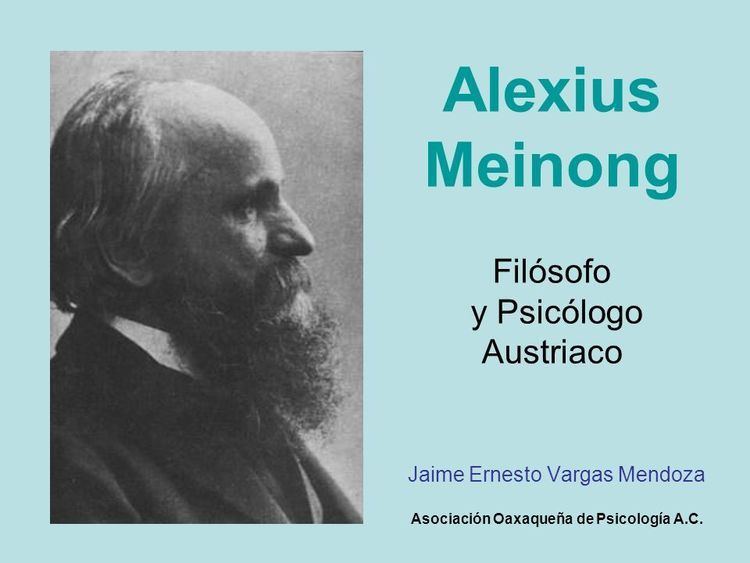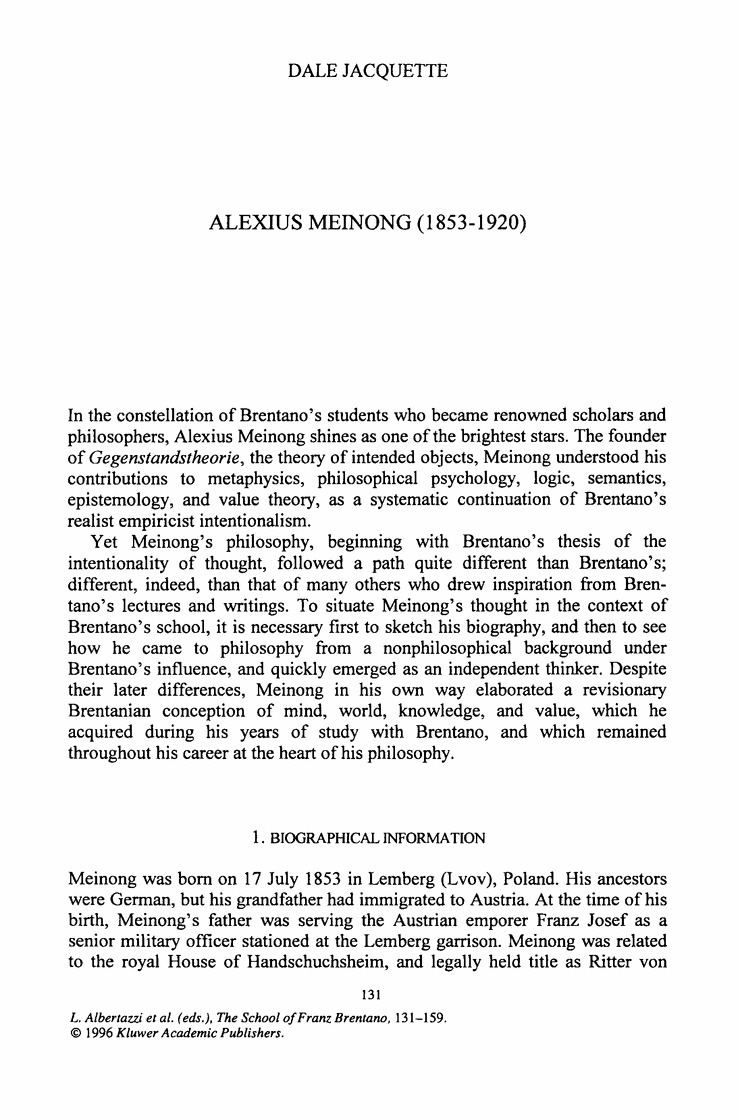Name Alexius Meinong | Role Philosopher | |
 | ||
Influenced Edward N. Zalta, Richard Honigswald Books On assumptions, On Emotional Presentation, Logik Similar People | ||
Meinong's Jungle (Theory of Objects)
Alexius Meinong Ritter von Handschuchsheim (17 July 1853 – 27 November 1920) was an Austrian philosopher, a realist known for his unique ontology. He also made contributions to philosophy of mind and theory of value.
Contents

Life

Alexius Meinong's father was the Austrian officer Anton von Meinong (1799–1870), who was granted the hereditary title of Ritter in 1851 and reached the rank of Major General in 1858 before retiring in 1859.

Alexius Meinong studied at the Akademisches Gymnasium, Vienna and later the University of Vienna, where he read history and philosophy as a pupil of Franz Brentano. He was professor and Chair of Philosophy at the University of Graz, where he founded the Graz psychological institute (in 1894) and the Graz School of experimental psychology. Meinong supervised the promotions of Christian von Ehrenfels (founder of Gestalt psychology) and Adalbert Meingast, as well as the habilitation of Alois Höfler and Anton Oelzelt-Newin.
Ontology
Meinong wrote two early essays on David Hume, the first dealing with his theory of abstraction, the second with his theory of relations, and was relatively strongly influenced by British empiricism. He is most noted, however, for his Theory of Objects (Über Gegenstandstheorie, 1904), which grew out of his work on intentionality and his belief in the possibility of intending nonexistent objects. The theory is based around the purported empirical observation that it is possible to think about something, such as a golden mountain, even though that object does not exist. Since we can refer to such things, they must have some sort of being. Meinong thus distinguishes the "being" of a thing, in virtue of which it may be an object of thought, from a thing's "existence", which is the substantive ontological status ascribed, for example, to horses but denied to unicorns. Meinong called such nonexistent objects "homeless"; others have nicknamed their place of residence "Meinong's jungle" because of their great number and exotic nature.
Historically, Meinong has been treated, especially by Gilbert Ryle, as an eccentric whose theory of objects was allegedly dealt a severe blow in Bertrand Russell's essay "On Denoting". However, Russell himself thought highly of the vast majority of Meinong's work and, until formulating his theory of descriptions, held similar views about non-existent objects. Further, recent Meinongians such as Terence Parsons and Roderick Chisholm have established the consistency of a Meinongian theory of objects, while others (e.g., Karel Lambert) have defended the usefulness of such a theory.
Meinong is also seen to be controversial in the field of philosophy of language for holding the view that "existence" is merely a property of an object, just as color or mass might be a property. Closer readers of his work, however, accept that Meinong held the view that objects are "indifferent to being" and that they stand "beyond being and non-being". On this view Meinong is expressly denying that existence is a property of an object. For Meinong, what an object is, its real essence, depends on the properties of the object. These properties are genuinely possessed whether the object exists or not, and so existence cannot be a mere property of an object.
Types of objects
Meinong holds that objects can be divided into three categories on the basis of their ontological status. Objects may have one of the following three modalities of being and non-being:
Certain objects can exist (mountains, birds, etc.); others cannot in principle ever exist, such as the objects of mathematics (numbers, theorems, etc.): such objects simply subsist. Finally, a third class of objects cannot even subsist, such as impossible objects (e.g. square circle, wooden iron, etc.). Being-given is not a minimal mode of being, because it is not a mode of being at all. Rather, to be "given" is just to be an object. Being-given, termed "absistence" by J.N. Findlay, is better thought of as a mode of non-being than as a mode of being. Absistence, unlike existence and subsistence, does not have a negation; everything absists. (Note that all objects absist, while some subset of these subsist, of which a yet-smaller subset exist.) The result that everything absists allows Meinong to deal with our ability to affirm the non-being (Nichtsein) of an object. Its absistence is evidenced by our act of intending it, which is logically prior to our denying that it has being.
Object and subject
Meinong distinguishes four classes of "objects":
To these four classes of objects correspond four classes of psychological acts:
